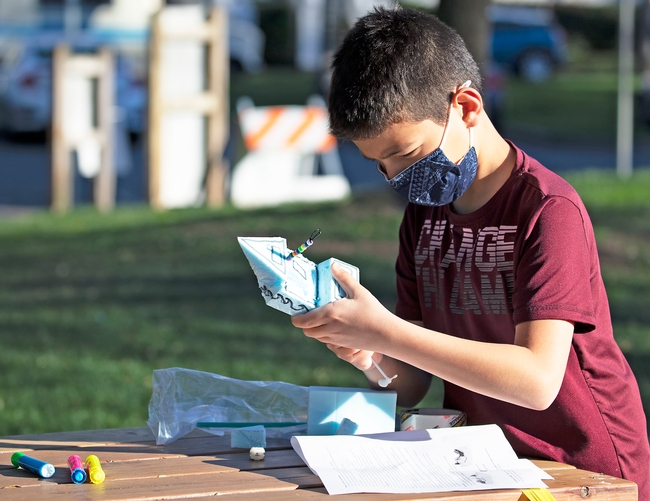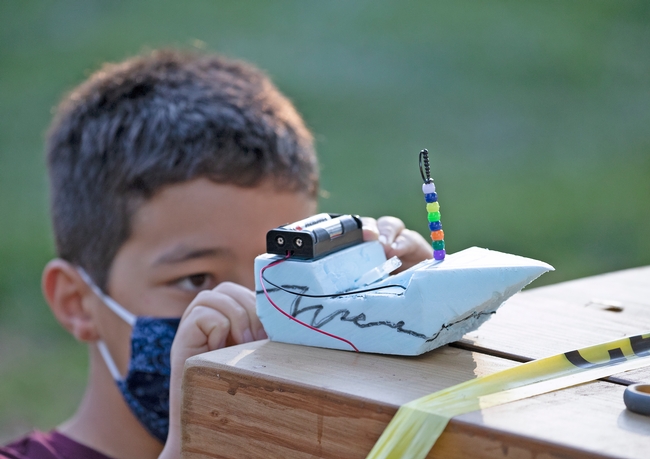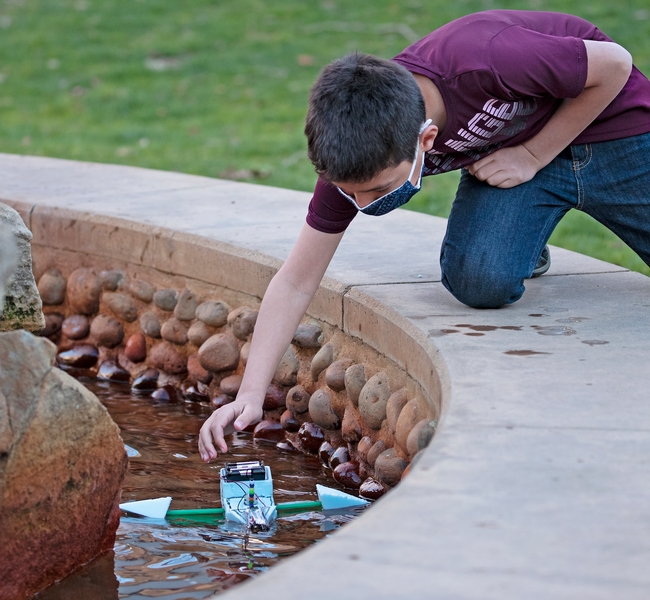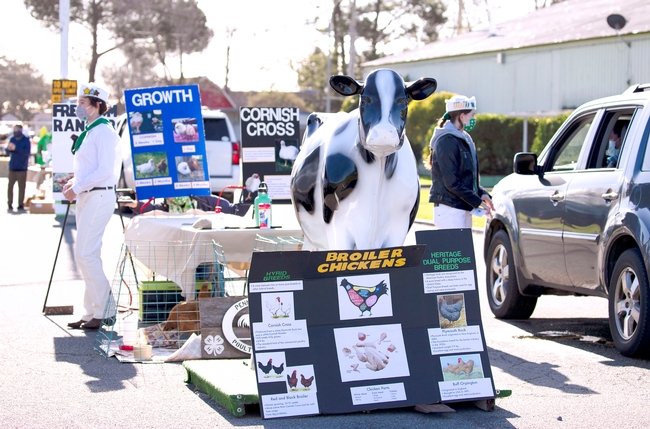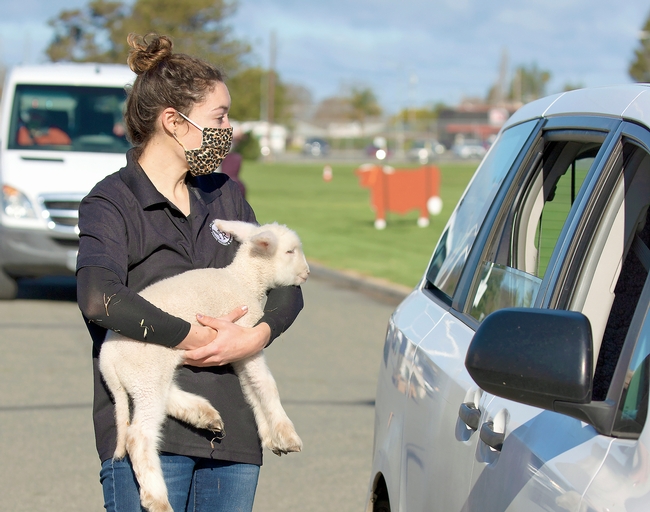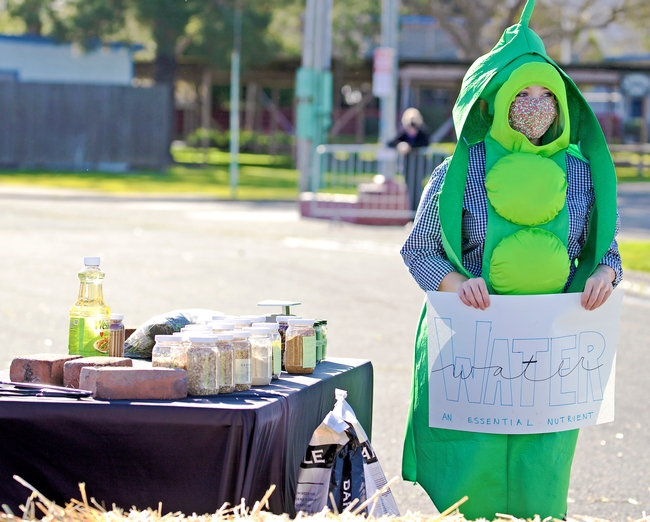As many students continue online learning due to COVID-19, 4-H hands-on learning activities are keeping them excited and engaged in education. The University of California's 4-H Youth Development Program has created several learning activities that allow children to interact within COVID-19 guidelines.
“Despite constraints imposed by the pandemic, 4-H has adapted to continue engaging young people in hands-on STEM learning,” said Steven Worker, Ph.D., UC Cooperative Extension 4-H advisor for Marin, Napa and Sonoma counties.
Students build motorboats for Engineers Week
During Engineers Week, Feb. 21-27, 4-H is challenging kids age 5 to 18 to design, build and test a motorboat.
The activity is intended to spark students' interest in engineering and technology and to exercise their creativity. The boat kit is basic, allowing children to use their imagination, repurposing things around the house to customize their boats.
Starting with a rectangular foam block (2"x2"x8"), youths carve out the body of their toy boats, then install the motor, power switch, propeller and battery holder.
Fifth-grader Sarp Akalin assembled his battery-powered motorboat, which featured a colorful column of white, blue, yellow orange and purple beads, then tested its water worthiness in an outdoor, large stone fountain in Mountain View.
Sarp, who assembled a 4-H Mars rover for a STEM project last year, said the boat was more challenging because the rover kit included all the pieces required to operate the vehicle. To build a functional boat, he had to figure out how to mount the batteries and motor and balance the center of gravity, connect them with electrical wires, then make sure the propeller had the right amount of space spinning freely the right direction to thrust the boat forward.
He learned a few adjustments were needed to float the boat. For example, whenSarp first placed the boat in the water, he let out a yelp as the weight of the battery pack sank the back end. With some guidance from his fatherEmre,Sarp balanced the weight by strapping two batteries to the front end and placed it back in the water. After the boat listed to one side, he converted the boat to a trimaran – a type of sailboat which is mostly used for racing – which stabilized the vessel.
“The best part was seeing it go,” Sarp said of watching his boat propel itself around the large rocks in the turbulent water in the fountain.
On Saturday, Feb. 27, nearly 150 4-H youths from 22 California counties will gather online to show their completed boats, maybe demonstrate them in a bathtub or pool, and describe their design experience.
Participating counties include Alameda, Butte, Contra Costa, Imperial, Kern, Kings, Madera, Monterey, Napa, Riverside, San Diego, San Luis Obispo, San Mateo, Santa Barbara, Santa Clara, Shasta, Solano, Sonoma, Stanislaus, Tulare, Tuolumne, Ventura and Yolo.
“While meeting virtually is not the same as meeting in person, thankfully we have technology to connect us by sight and sound over long distances,” Worker said. “On Saturday, I am eager to see the creativity, ingenuity and persistence young people display in their completed motorboats.”
More information about the boat challenge is at https://ucanr.edu/boat.
Drive-through animal science presentations
In Petaluma, 4-H members learned about animal science at the Sonoma-Marin Fairgrounds on Feb. 20. More than 130 participants drove to presentation stations within the fairgrounds. From the safety of their cars, the youths learned about livestock production. Poultry, beef cattle, dairy cattle, sheep and goat experts from UC Cooperative Extension and local organizations gave presentations.
Randi Black, UCCE dairy advisor, and Amy Housman of Santa Rosa Junior College provided tips for biosecurity to keep animals healthy. Maurice Pitesky, UC Cooperative Extension poultry specialist, and 4-H members Carson Hay, Frances Marshall, Jessica Waterman and Zoey Haines shared information about raising chickens, egg production and broiler production. Sonoma-Marin Cattlewomen and North Bay Dairy Women discussed raising beef and dairy cattle, cattle byproducts, the use of cattle grazing to help reduce wildfire fuel. Sheep and goat production were covered by Erin Monahan of Two Willow Club Lambs, Riggs Lokka and Emily Dulany of Top of the Hill Boer Goats, and Janet and Rebecca Kracker, Sonoma County 4-H leaders.
Members of the Sonoma-Marin Young Farmers and Ranchers and Napa County Young Farmers and Ranchers discussed animals' nutrition needs. “They showed the kids different feedstuffs, broke down the different ingredients that animal feeds contain, and explained what the different feedstuffs do for the animals,” said Suzanne Amaral, UC Cooperative Extension 4-H program coordinator for Napa County.
Julie Atwood of the Halter Project gave suggestions for planning for evacuating livestock in the event of a wildfire.
Join Discovery Day on March 13
Children, teens and families are invited to join 4-H and other Bay Area organizations for North Bay Science Discovery Day on Saturday, March 13. Events are scheduled between 9 a.m. and 6 p.m. Pacific time.
Discovery Day is a designed to spark curiosity and excitement about science, technology, engineering, and mathematics (STEM). A Kaiser Permanente physician will describe how the COVID-19 vaccination works. Kids can learn how rockets launch and make their own at home. They can learn about wildlife conservation from the Petaluma Wildlife Museum. They can design, build and test a 4-H scribbling machine that will make drawings on paper. These and many other activities are planned. For more information and to register, visit https://www.northbayscience.org/2021.
The virtual public science festival is free and open to youth of all ages across California.
